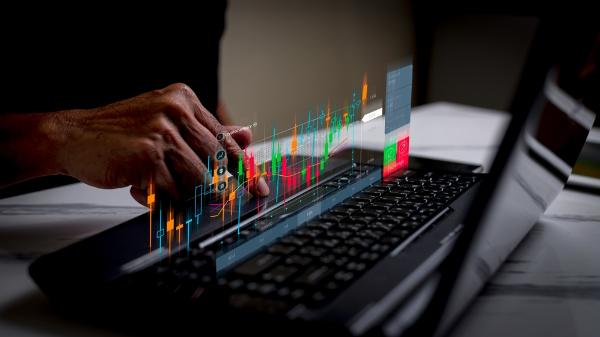Market Risk vs Market Volatility: What are the Key Differences

Strong 8k brings an ultra-HD IPTV experience to your living room and your pocket.
In trading, a common concern for traders is understanding the distinction between market volatility and market risks. These two terms are often mistaken for one another, causing undue stress and potential financial losses. To navigate the trading world successfully, it’s essential to grasp the difference between these concepts. In this comprehensive guide, we will explore the key differences between market risk and Volatility and offer strategies for managing both effectively.
Overview: Differences between Market Risk and Volatility
Market Risk Market Volatility
Nature Market Risk is the probability of an investor losing money due to broader economic factors.
Market Volatility measures how much the price of a security fluctuates over time.
Impact Market Risk is always present in some form, and traders must prepare for it. Volatility can be intermittent and doesn’t always result in financial losses.
Management Market Risk management in forex requires strategies like diversification, hedging, and stop-loss orders. Volatility is best managed by adjusting exposure, setting tighter stop-losses, and avoiding over-leveraging during high-volatility periods.
let’s understand the two concepts in detail-
What is Market Risk?
Market risk refers to the possibility that an investor will experience losses due to factors that affect the entire market or a particular sector. It’s also known as systematic risk because it is inherent to all types of financial markets and cannot be eliminated through diversification. This type of risk arises from macroeconomic variables like interest rates, currency fluctuations, inflation, and geopolitical events.
For example, in forex trading, market risk could be influenced by changes in a country's economic policies, interest rates, or political events. These factors can cause the entire currency market to shift, impacting all trading pairs and leading to losses if traders are unprepared. Managing market risk requires robust risk management strategies that protect the trader from falling for common forex trading psychology and from unexpected market movements.
Key examples of market risk include:
• Interest Rate Risk: The risk of fluctuations in interest rates that affect investment returns.
• Currency Risk: The risk arising from fluctuations in foreign exchange rates.
• Inflation Risk: The potential for inflation to erode the purchasing power of investment returns.
Strategies to Manage Market Risk
Effectively managing market risk is essential to protect the capital and reduce the likelihood of losses.
Here are some key strategies to help manage market risk:
• Diversification: This involves spreading the investments across different asset classes, sectors, or geographies to reduce exposure to any single market's risk.
• Hedging: By using financial instruments like options, futures, or forex traders can hedge against adverse price movements. For example, forex traders might use currency options to protect against unfavourable currency fluctuations.
• Stop-loss orders: A stop-loss order automatically sells a position when the price reaches a certain level, preventing further losses. This is especially useful in volatile markets where prices can change rapidly.
• Position Sizing: Ensuring that no single trade constitutes too large a portion of their portfolio can help traders manage risk by limiting the impact of any one loss on their overall capital.
• Stay Updated on Economic Indicators: It is essential to regularly monitor interest rates, inflation data, and geopolitical news to anticipate market changes. Understanding these factors can help traders make informed decisions and prepare for shifts in market risk.
What is Market Volatility?
Market volatility refers to the frequency and magnitude of price movements within a given market. In more volatile markets, prices can swing dramatically in either direction within a short period. Volatility can be triggered by both internal and external events, such as earnings reports, political developments, or shifts in investor sentiment.
High volatility often correlates with uncertainty in the market, which can either present opportunities or risks depending on a trader's strategy. For example, in forex trading, a high-volatility environment may provide more trading opportunities due to larger price swings. However, it also increases the risk of significant losses if the market moves against a trader’s position.
While volatility doesn’t directly equate to market risk, it amplifies the potential for rapid gains or losses, making it an important factor for traders to monitor closely.
Key examples of volatility include:
• Price Swings in Stocks: Major company announcements can lead to significant stock price fluctuations.
• Forex Market Fluctuations: Political instability can cause currency prices to move sharply in a short period.
Strategies to Manage Market Volatility
Volatility management is about preparing for unpredictable price movements and ensuring they are well-positioned to take advantage of opportunities without exposing yourself to excessive risk.
Here are some strategies to help manage market volatility:
• Lower Leverage: Using too much leverage in volatile markets can amplify both gains and losses. However, reducing leverage limits their risk exposure.
• Tighter Stop-Losses: In a volatile market, prices can swing quickly. Thus, it is essential to set tighter stop-loss levels as it allows traders to minimize losses when the market moves against their trade.
• Stay Disciplined with a Trading Plan: Traders must develop a clear trading plan that includes entry and exit strategies. This will help them to stay focused and avoid making emotional decisions during periods of high volatility.
• Use Volatility Indicators: Indicators like the Average True Range (ATR) can help traders assess the level of volatility and adjust their strategy accordingly.
• Stay Calm and Avoid Overreacting: High volatility can cause emotional reactions that lead to impulsive decisions. Practising sound forex trading psychology can help them manage emotions, stay patient, and avoid unnecessary losses.
Conclusion
To conclude, Market volatility is the measure of the price movement of a single or a set of securities while market risk is the possibility of losing money invested in the financial markets. While market risk and market volatility are closely related, they represent distinct challenges for traders. Thus, understanding the differences between market risk and volatility is crucial to developing an effective trading strategy.
Note: IndiBlogHub features both user-submitted and editorial content. We do not verify third-party contributions. Read our Disclaimer and Privacy Policyfor details.


